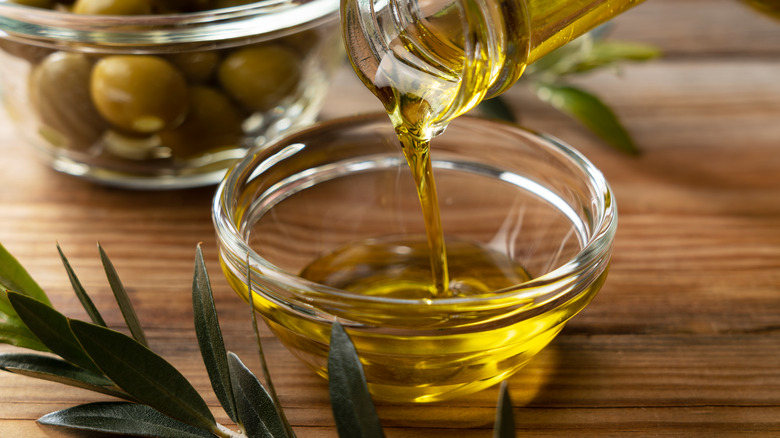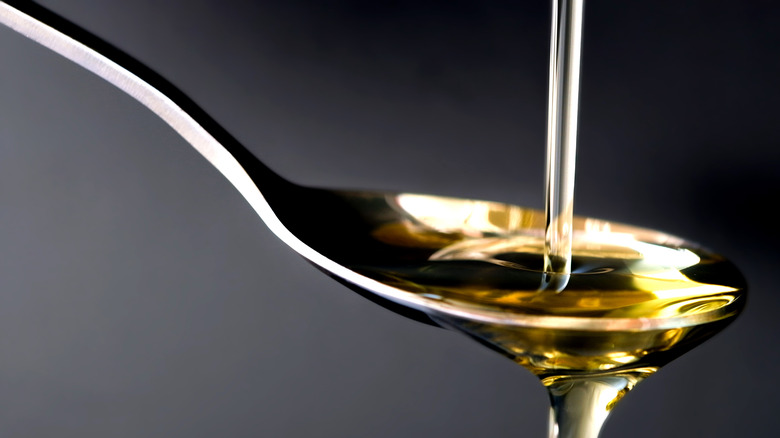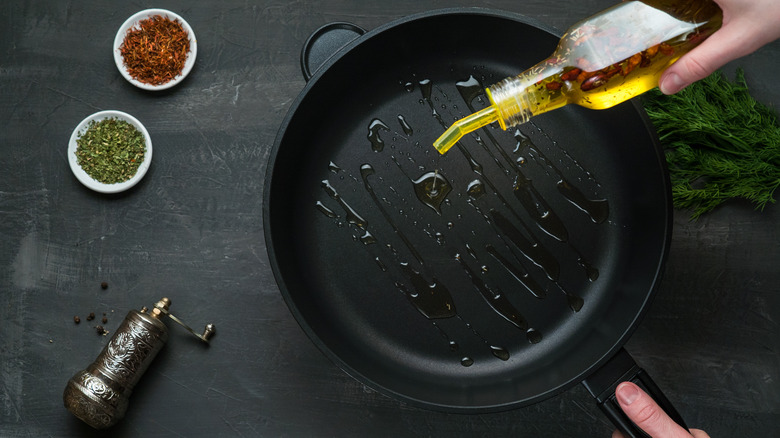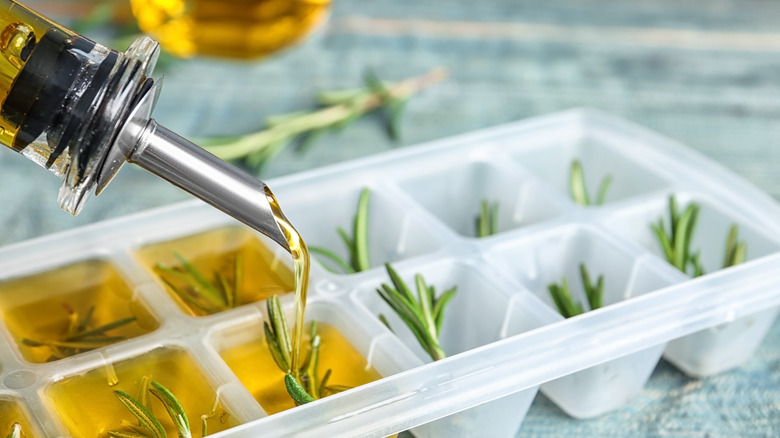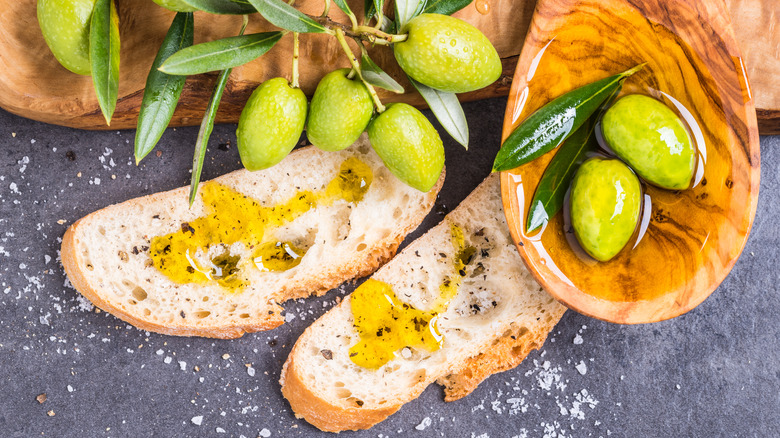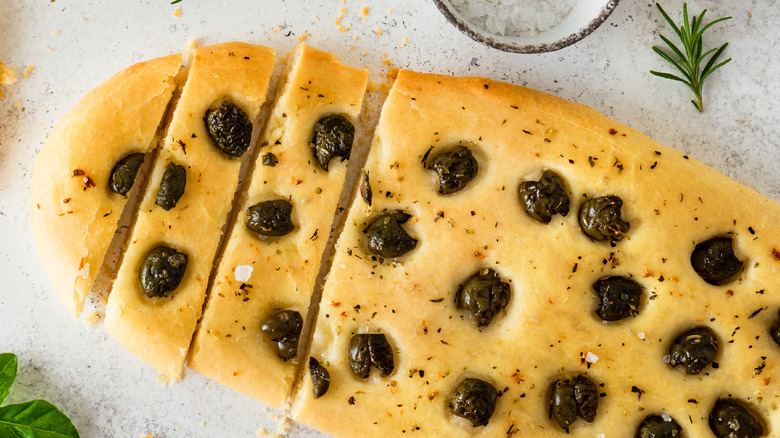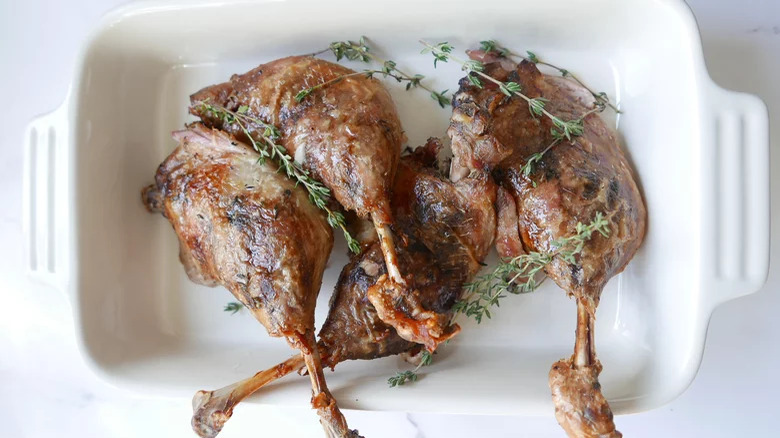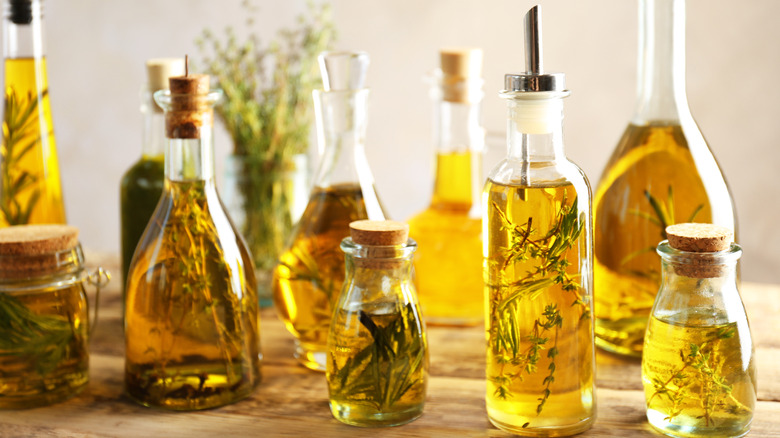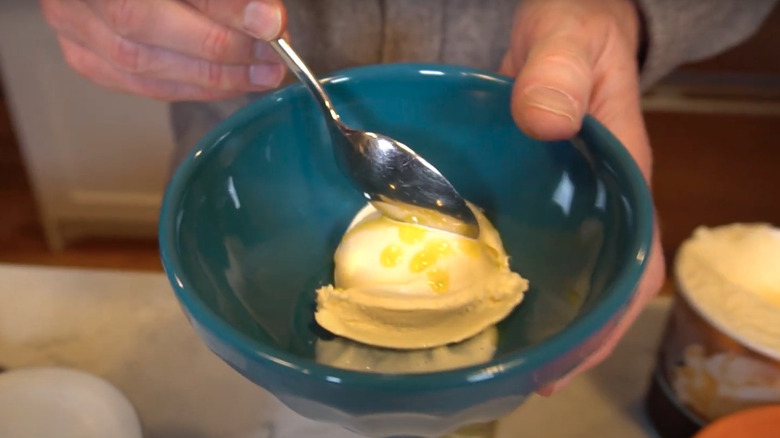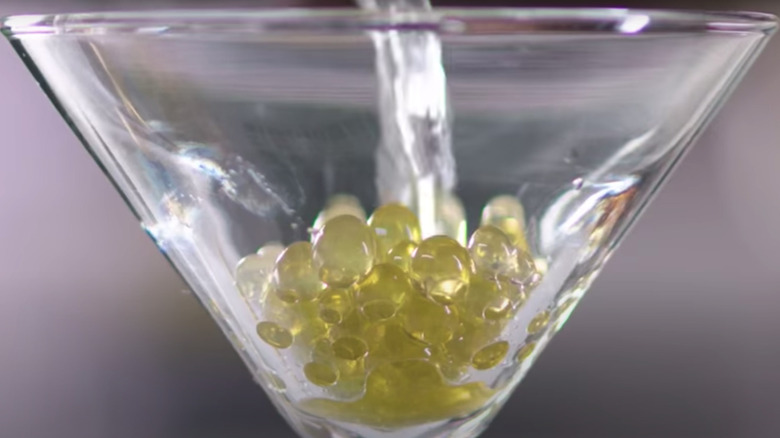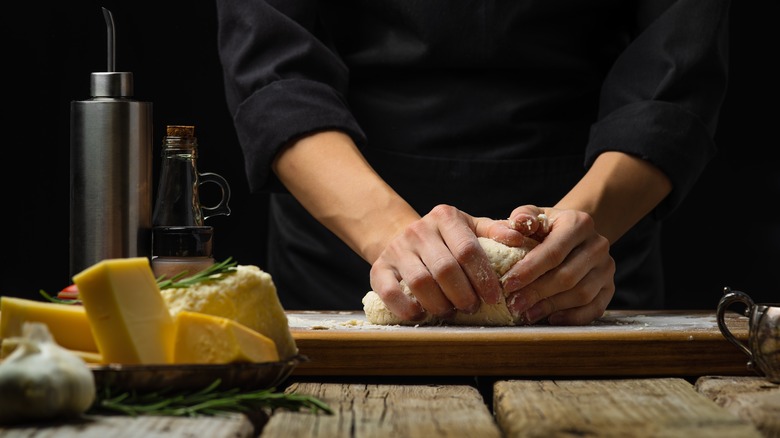10 Olive Oil Tips You'll Want To Try
If there's one must-have kitchen staple all good home chefs love, it's a quality bottle of olive oil. You can fry with it, use it to top various dishes, and dunk ingredients into it all in the name of incredible cooking and eating. It's also healthy, as it contains "good fats" that can help lower "bad" cholesterol, and has anti-inflammatory properties (via Harvard Medical School). Another wonder of olive oil is that you don't even need to cook with it — you can just enjoy it as is. The price of olive oil varies wildly, as does the quality, so you might want to check out our list of affordable olive oils ranked worst to best before you hit up the grocery store.
Considering the versatility of this ingredient, you know there are plenty of tips and tricks for chefs and foodies alike. From freezing herby olive oil cubes to mixing olive oil into bread dough, homemade recipes for infusing oil with lemon and garlic to the surprisingly delicious addition of drizzling it on top of ice cream, there is a lot to learn. Here are 10 olive oil tips you'll want to try, and likely come back to time and time again.
Use the plastic tab for a better pour
Olive oil either comes in glass or plastic bottles, but no matter the material, what's important is that they're not transparent. UV rays really affect olive oil and can make it go bad. The best way to store it is in a dark-colored bottle, which will keep it protected (via OliveOil.com). You may find that some bottles don't have a spout that properly controls the oil when you pour it. If the opening is quite wide when you take off the top, it's easier for more oil to come gushing out than you may want. This can ruin a dish — such as a caprese salad — because what you want is just a drizzle of olive oil, and not for your ingredients to be swimming in it.
If you've struggled with this before, then you're going to love this TikTok hack that is a once-you-know-you-know tip — it's what you'll do each time you open a new bottle of oil. Take the cap off your olive oil and pull off the little plastic tab inside. Just be careful to do this gently, as it may break if you yank it too forcefully. Instead of throwing it away, turn it upside down and place it back into the neck of the bottle. Push it down so that it's secure. It'll now control the flow of oil as you pour.
Measure without a spoon
If you tend to follow your culinary instinct rather than sticking rigidly to a set recipe, then bravo to you. However, adhering to proper measurements creates balance in a dish, affecting the taste, texture, and even how the other ingredients cook. Take olive oil, for instance. It lends itself to so many dishes and even if you're making a simple vinaigrette, you'll want to get the right ratio of olive oil to vinegar. Some home cooks like the idea of free-pouring instead of using a measuring spoon (plus, it allows for one less thing that needs to be washed).
This is not a problem, as there's a clever TikTok tip at hand. It only works if your olive oil container has one of those long, thin spouts. As you pour your olive oil, you just need to keep count. Say you want a tablespoon of oil added to a pan, then all you have to do is just count to six while you pour. A 6-second pour equates to a tablespoon. You can test the theory by counting your pour into an actual tablespoon to see if it measures up. Give it a try!
Freeze herby cubes
You probably store your oil in the cupboard, or if you cook with it all the time, then right by the stove. Well, we have another place you may want to keep it, and it's especially practical if you like cooking with herbs too. This surprise location is actually the freezer — in ice cube trays with the addition of your favorite herbs — which is also a great way to preserve your fragrant greenery and prevent it from going bad.
The Pioneer Woman is a big fan of this hack. You can then add your frozen herby oil cubes to so many dishes, such as stews, roasts, or even on top of a fresh serving of mashed potatoes. It's advised not to use soft herbs for this, as more robust or woody ones work best, such as rosemary and thyme. Remove any stalks and add the herb leaves to your ice cube tray so each well is half full. You may need to chop them up a bit to fit. Top up with extra virgin olive oil, cover, and freeze. You can take the olive oil cubes out once they're frozen and transfer them to a bag to store in the freezer, in case you need to free up those ice cube trays. You can also do this with garlic by mixing minced garlic and olive oil, and then spooning it into the ice cube tray. Just make sure to double-bag the frozen cubes so the odor doesn't take over the freezer (via TikTok).
Save extra virgin olive oil for cold dishes
You may have heard it said before that you shouldn't heat olive oil because of its smoke point. However, the USDA has turned this on its head by announcing that it's perfectly safe to deep-fry with the oil. What's more, it's suggested that many of the health benefits, such as antioxidants and anti-inflammatory properties, aren't destroyed at frying temperatures either. This is all good news, but it's also worth noting that olive oil isn't just for cooking with heat, but for eating cold too. This may be welcomed news as olive oil isn't the cheapest oil on the market, so some may not want to use it in the large quantities you would need for frying.
What about the different kinds of olive oils? Extra virgin olive oil is cold-pressed from olives and is quite distinct from other olive oils. According to the International Olive Council, there is also just virgin olive oil, refined olive oil, and even olive oil that's not fit for consumption. In essence, extra virgin olive oil is the highest quality and most expensive. Cook with olive oil by all means, but keep your highest quality extra virgin olive oil for cold dishes when you want to taste the full flavor. One of the simplest ways to enjoy olive oil is to drizzle it over fresh salad ingredients, or even paring it with a crusty piece of bread for dipping.
Roll olive oil into bread dough
Inside most kitchen cupboards there are requisite pots and pans and mixing bowls of various sizes. If you love baking, you'll no doubt appreciate these bread hacks, and if you're a fan of olive oil, then you're going to want to try out an interesting tip suggested by artisan baker and founder of Panary, Paul Merry. It's a great mess-free and handy tip for adding olive oil and olives to dough.
Before you begin, you're going to need a large plastic tub. Add olive oil and chopped olives (the latter of which are optional) to a tub. Lay your finished bread dough on top. Push down on the dough with your knuckles to press it into the oil, so that a layer covers the bottom of the tub. Pull the far edge of the dough up and fold it over toward you, pressing as you do. What you're essentially doing is rolling the dough over. After a few movements, it should resemble a log shape. Turn it so it's lengthways in the tub and the seam from rolling is facing up. Press down and start to roll the dough once again. Continue to turn and roll several times, using your thumbs in a firm yet pliable way with the right amount of pressure. Leave the dough to rest for about five minutes before continuing to roll until all the olive oil has been absorbed. Now you're ready to bake!
Use in place of other fats for confit
A more traditional duck confit recipe uses duck fat, but did you know that you can use olive oil instead? As recipe developer Ting Dalton told us of her duck confit recipe, "I use olive oil for ease, but traditional recipes call for duck fat. Olive oil is a little healthier than duck fat and more easily available." With the duck fat method, it takes quite a bit of time to render the fat, whereas it takes much less time if you simply use olive oil (via Wine Country Table).
The amount of fat is the same, but the levels of saturated fats in olive oil are far less, making it somewhat healthier. An extra part to this tip is marinating the duck in olive oil for a few days before cooking with fresh olive oil. Put the uncooked duck legs in olive oil in the fridge for two days, stirring daily. On the third day, stir once again, and then when you're ready, remove any excess marinade, and cook. Store the cooked, cooled-down meat in its oil, and it'll last for a couple of weeks in the fridge.
TikToker @alexawhatsfordinner suggests using olive oil to make garlic confit. Cook it in the oven for a couple of hours with salt and thyme and serve your soft, oily garlic on a hunk of crusty baguette. You can also store it in the fridge submerged in the oil for up to a week.
Safely infuse olive oil
Virgin olive oils are lighter and taste much mellower than their non-virgin counterparts. These oils work tremendously well when you cook with herbs and spices. Let's face it, a splash of olive oil in a pan with some garlic, and anyone in the vicinity is going to be asking you what you're cooking (and more importantly, when they can eat it). However, infused oils also work well, especially if you want to add some herby essence to a dressing. The North American Olive Oil Association offers tips on how to properly infuse olive oil to safeguard against food poisoning.
Use herbs and spices that are dried instead of fresh herbs. The lack of water means bacteria has less chance to grow. While you may like the laid-back idea of just sticking a few herbs in some oil, take the time to first boil-wash bottles for 10 minutes at minimum. While some ingredients may languish at the back of your cupboards, keep infused oil in the fridge. They also recommend using it within a few days.
Actress Jennifer Garner is a fan of olive oil infused with lemon and garlic, as well a thyme and chili flakes. She uses it as a marinade for tuna, which she then cooks and combines with brown rice, kale, and avocado. She said she always reserves a little extra to drizzle on top as a dressing.
Drizzle on ice cream
There are so many toppings to add to a scoop of ice cream. You've got strawberry and chocolate sauces, sprinkles, nuts, and fruit. You can be as creative as you like, and if you're a real fan of this dairy delight, you can check out this recipe for an easy, no-churn vanilla ice cream. However, the culinary world of ice cream is opening up to new ideas. What's becoming increasingly popular is more obscure toppings or mix-ins, such as this caramelized soy sauce ice cream highlighted on Trend Hunter.
It's not too much of a stretch then to imagine that olive oil and ice cream could be a silky-smooth dessert match, and not as odd as it first sounds. As Cook's Illustrated notes on Instagram, you wouldn't think twice about adding olive oil to cheese, so why not on top of ice cream? Meanwhile, one commenter suggests adding some balsamic vinegar as well. Follow a TikTok tip to not only pour olive oil over vanilla ice cream, but also sprinkle on some sea salt. Love & Olive Oil suggests also making ice cream with olive oil. It gives the ice cream a distinct creamy, but clean, taste — just be sure to use only a recently opened bottle of olive oil, otherwise the flavor may not be as fresh.
Make olive juice pearls with olive oil
Olive oil pearls look so cool. These delicate, caviar-esque balls transform any dish and, if you're the one who's made them for a dinner party, then you'll be basking in praise for your culinary skills for a long time to come. You don't just have to add them to a savory dish either. Olive pearls made with olive oil look stunning in a dirty martini, as the Food Network shows on YouTube, and they're not complicated to make either.
Bring 200 grams of olive juice and 3 grams of agar-agar powder to boil in a pan and whisk for a couple of minutes. Once cooled, add the liquid to a plastic bottle with a squirt spout. Then, slowly squeeze the juice mix into a cup full of olive oil and marvel at how it forms balls as it falls into the oil. Scoop them out and make sure to rinse them before adding a spoonful to a martini glass, followed by some chilled liquor. This will make for a great dirty martini, using either gin or vodka. Garnish your olive pearl dirty martini with an olive (what else?). You may want to also use these pearls to add a decorative flavor to dishes, in the way that world-famous restaurant elBulli once did (via Olive Oil Times).
Add to pizza dough
At most pizzerias, there's a bottle of chili oil to add spice to a slice. Or, perhaps, just plain olive oil. The point is, olive oil pairs perfectly with pizza — either as a topping, or mixed into the dough. Let's talk about the latter and use We Like Pizza as a reference.
If you're going to use olive oil in your pizza dough, just make sure to add it after you've mixed all the other ingredients so that no essential processes are stopped by the oil. Olive oil gives flavor, and it makes the dough a little softer too, without interfering with it rising. You can use any type of olive oil, but extra virgin olive oil is recommended. You can also use infused olive oil to enhance the taste. Your pizza crust will brown nicely and be extra crunchy, while the dough will be more resistant to becoming soggy with any toppings. If you add too much oil and the dough becomes wet, just add in some more flour to balance that out. Experiment with how much oil you use and see how it affects the flavor, texture, and crispiness factor of your pizza.
